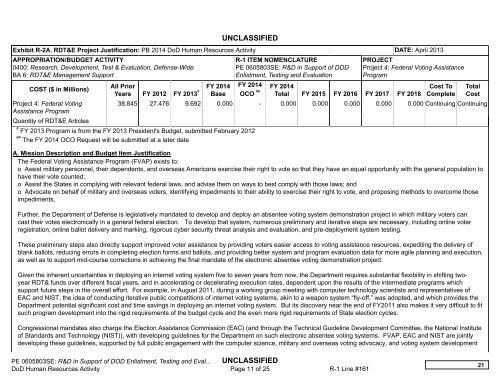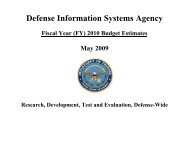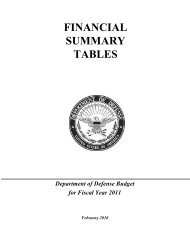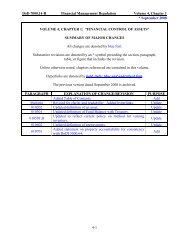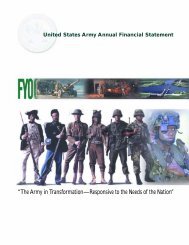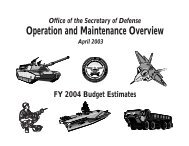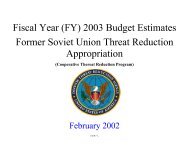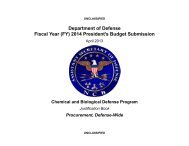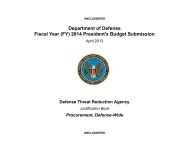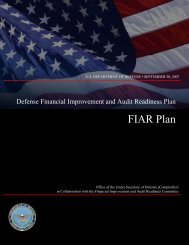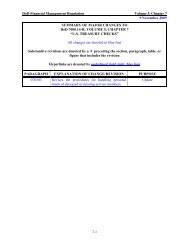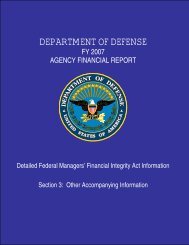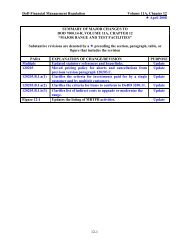Defense Human Resources Activity - Office of the Under Secretary of ...
Defense Human Resources Activity - Office of the Under Secretary of ...
Defense Human Resources Activity - Office of the Under Secretary of ...
Create successful ePaper yourself
Turn your PDF publications into a flip-book with our unique Google optimized e-Paper software.
UNCLASSIFIED<br />
Exhibit R-2A, RDT&E Project Justification: PB 2014 DoD <strong>Human</strong> <strong>Resources</strong> <strong>Activity</strong> DATE: April 2013<br />
APPROPRIATION/BUDGET ACTIVITY<br />
0400: Research, Development, Test & Evaluation, <strong>Defense</strong>-Wide<br />
BA 6: RDT&E Management Support<br />
COST ($ in Millions)<br />
Project 4: Federal Voting<br />
Assistance Program<br />
Quantity <strong>of</strong> RDT&E Articles<br />
All Prior<br />
Years FY 2012 FY 2013 #<br />
FY 2014<br />
Base<br />
R-1 ITEM NOMENCLATURE<br />
PE 0605803SE: R&D in Support <strong>of</strong> DOD<br />
Enlistment, Testing and Evaluation<br />
FY 2014<br />
OCO ##<br />
PE 0605803SE: R&D in Support <strong>of</strong> DOD Enlistment, Testing and Eval... UNCLASSIFIED<br />
DoD <strong>Human</strong> <strong>Resources</strong> <strong>Activity</strong> Page 11 <strong>of</strong> 25 R-1 Line #161<br />
PROJECT<br />
Project 4: Federal Voting Assistance<br />
Program<br />
FY 2014<br />
Total FY 2015 FY 2016 FY 2017 FY 2018<br />
Cost To<br />
Complete<br />
38.845 27.476 9.692 0.000 - 0.000 0.000 0.000 0.000 0.000 Continuing Continuing<br />
# FY 2013 Program is from <strong>the</strong> FY 2013 President's Budget, submitted February 2012<br />
## The FY 2014 OCO Request will be submitted at a later date<br />
A. Mission Description and Budget Item Justification<br />
The Federal Voting Assistance Program (FVAP) exists to:<br />
o Assist military personnel, <strong>the</strong>ir dependents, and overseas Americans exercise <strong>the</strong>ir right to vote so that <strong>the</strong>y have an equal opportunity with <strong>the</strong> general population to<br />
have <strong>the</strong>ir vote counted;<br />
o Assist <strong>the</strong> States in complying with relevant federal laws, and advise <strong>the</strong>m on ways to best comply with those laws; and<br />
o Advocate on behalf <strong>of</strong> military and overseas voters, identifying impediments to <strong>the</strong>ir ability to exercise <strong>the</strong>ir right to vote, and proposing methods to overcome those<br />
impediments.<br />
Fur<strong>the</strong>r, <strong>the</strong> Department <strong>of</strong> <strong>Defense</strong> is legislatively mandated to develop and deploy an absentee voting system demonstration project in which military voters can<br />
cast <strong>the</strong>ir votes electronically in a general federal election. To develop that system, numerous preliminary and iterative steps are necessary, including online voter<br />
registration, online ballot delivery and marking, rigorous cyber security threat analysis and evaluation, and pre-deployment system testing.<br />
These preliminary steps also directly support improved voter assistance by providing voters easier access to voting assistance resources, expediting <strong>the</strong> delivery <strong>of</strong><br />
blank ballots, reducing errors in completing election forms and ballots, and providing better system and program evaluation data for more agile planning and execution,<br />
as well as to support mid-course corrections in achieving <strong>the</strong> final mandate <strong>of</strong> <strong>the</strong> electronic absentee voting demonstration project.<br />
Given <strong>the</strong> inherent uncertainties in deploying an internet voting system five to seven years from now, <strong>the</strong> Department requires substantial flexibility in shifting twoyear<br />
RDT& funds over different fiscal years, and in accelerating or decelerating execution rates, dependent upon <strong>the</strong> results <strong>of</strong> <strong>the</strong> intermediate programs which<br />
support future steps in <strong>the</strong> overall effort. For example, in August 2011, during a working group meeting with computer technology scientists and representatives <strong>of</strong><br />
EAC and NIST, <strong>the</strong> idea <strong>of</strong> conducting iterative public competitions <strong>of</strong> internet voting systems, akin to a weapon system “fly-<strong>of</strong>f,” was adopted, and which provides <strong>the</strong><br />
Department potential significant cost and time savings in deploying an internet voting system. But its discovery near <strong>the</strong> end <strong>of</strong> FY2011 also makes it very difficult to fit<br />
such program development into <strong>the</strong> rigid requirements <strong>of</strong> <strong>the</strong> budget cycle and <strong>the</strong> even more rigid requirements <strong>of</strong> State election cycles.<br />
Congressional mandates also charge <strong>the</strong> Election Assistance Commission (EAC) (and through <strong>the</strong> Technical Guideline Development Committee, <strong>the</strong> National Institute<br />
<strong>of</strong> Standards and Technology (NIST)), with developing guidelines for <strong>the</strong> Department on such electronic absentee voting systems. FVAP, EAC and NIST are jointly<br />
developing <strong>the</strong>se guidelines, supported by full public engagement with <strong>the</strong> computer science, military and overseas voting advocacy, and voting system development<br />
Total<br />
Cost<br />
21


